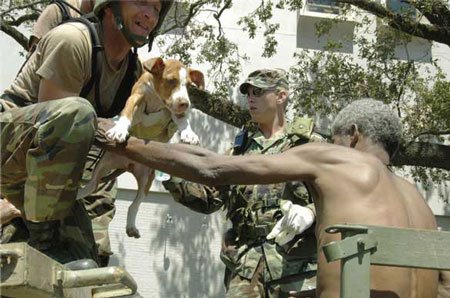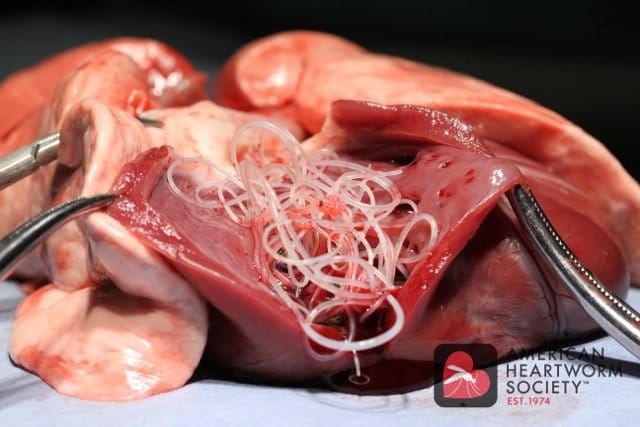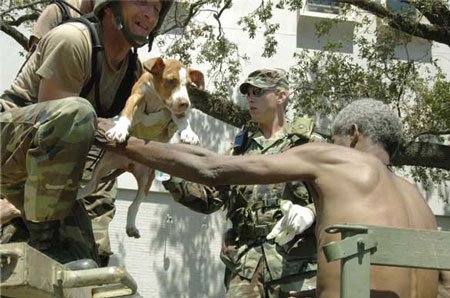Climate change and global warming are expected to increase the frequency and intensity of extreme weather events including heat waves, cold waves, floods, droughts, tornadoes, cyclones, typhoons and hurricanes. Climate change also changes global patterns of disease, for example by altering the geographic range of mosquito vectors that transmit viral and parasitic pathogens. Increasing temperatures also accelerate the life cycles of vectors and parasites, causing more rapid maturation and faster transmission to the next host1,2.
In addition to long-term effects of climate change, individual extreme weather events can rapidly and calamitously spread pathogens. This phenomenon was illustrated dramatically by the spread of canine heartworm disease via dogs evacuated from the southeastern US following Hurricane Katrina.

Canine heartworm is caused by a parasitic nematode, Dirofilaria immitis3. The worm’s life cycle includes an extra life stage—microfilaria—between the embryo and first stage larva. Mosquitoes ingest microfilaria during blood meals from infected dogs, which then develop into infective larvae and are transmitted to other dogs when the mosquitoes bite again. Reservoir hosts, including cats, also play a role. Disease pathology is caused by the foot-long adult worms, which localize in the heart and lungs to cause severe lung disease, heart failure and death. Treatment of heartworm-positive dogs is often ineffective; the recommended control strategy is to give a monthly preventative medication and test dogs yearly for infection3.
Hurricane Katrina, a category 5 hurricane, battered the southeastern US in August 2005. Damage and flooding were particularly severe in New Orleans. Rescue and recovery efforts focused on human residents but tens of thousands of animals, including dogs, were displaced or permanently separated from their families. Part of the recovery effort involved finding these animals new homes. Animal welfare organizations volunteered to take in “Katrina dogs,” with over 8,500 dogs sent out for fostering and adoption throughout the US and Canada4.
While admirable, this effort created a perfect storm for dispersing canine heartworm. First, the Katrina-impacted area lies in the highest-risk region for canine heartworm: the hot, humid southeastern US5. Second, more than 56% of dogs seen by veterinarians in this region never receive a single dose of preventive medicine6; adding in stray dogs and those never seen by a vet boosts this percentage much further. Finally, as might be expected based on the above factors, between 60-85% of Katrina dogs were estimated to be heartworm-positive4. These dogs went on to spread heartworm to new locations wherever competent mosquito vectors were present.

A number of studies have investigated the continuing increase in prevalence and geographic range of heartworm7,8. Specific case studies of Katrina-fueled outbreaks include the city of Hamilton in Ontario, Canada—far outside endemic heartworm territory—which experienced a 10-fold increase in diagnosed cases after importing approximately 600 Katrina dogs in 20059. Outbreaks are exacerbated by a “low index of suspicion” for heartworm infection when parasites are newly introduced into a region. Veterinarians do not expect to see the disease, so transmission gains a head start before the epidemic is detected. The story of the Katrina dogs has raised awareness of this issue.
Hurricanes and other extreme weather events batter the southeastern US frequently. How can dogs be evacuated more responsibly? Before leaving a heartworm-endemic region, dogs should be tested, treated if appropriate, and started on monthly preventatives. Unfortunately, a 6-month pre-patent period occurs between the time of infection and production of microfilaria, which are detected by antigen testing. A prolonged quarantine before dogs can be evacuated from a hurricane disaster zone presents a logistical nightmare. As seen after Katrina, veterinary best practices are abandoned in the face of a crisis.
An additional complexity is the increasing failure of heartworm medications due to evolving drug resistance10,11. The combination of high heartworm prevalence and erratic use of preventatives in the southeastern US provides a prime breeding ground for resistance. Evacuation of infected dogs following hurricanes can spread not only garden-variety heartworms but also drug-resistant strains. Developing new products to overcome drug resistance in canine heartworms is an important goal of the animal health industry12.
References
- Huber JH et al (2018) Seasonal temperature variation influences climate suitability for dengue, chikungunya, and Zika transmission PLoS Negl Trop Dis. May 10;12(5):e0006451. doi: 10.1371/journal.pntd.0006451. eCollection 2018 May.
- Fouque F, Reeder JC (2019) Impact of past and on-going changes on climate and weather on vector-borne diseases transmission: a look at the evidence. Infect Dis Poverty. 2019 Jun 13;8(1):51. doi: 10.1186/s40249-019-0565-1.
- American Heartworm Society. Heartworm in Dogs. https://www.heartwormsociety.org/heartworms-in-dogs
- Cooke B (2006) Katrina dogs raise risk of heartworm. 2006 Aug 20; https://www.chicagotribune.com/news/ct-xpm-2006-08-20-0608190078-story.html
- DVM 360 (2017) “2017 Parasite Forecast Maps Predict Uptick in Heartworm, Lyme Infections” DVM 360, Apr. 29; http://veterinarynews.dvm360.com/2017-parasite-forecast-maps-predict-uptick-heartworm-lyme-infections
- American Heartworm Society. “Heartworm Preventive Resistance: Is It Possible?” American Heartworm Society, www.heartwormsociety.org/newsroom/in-the-news/81-heartworm-preventive-resistance-is-it-possible.
- Levy JK (2011) Prevalence of infectious diseases in cats and dogs rescued following Hurricane Katrina. J Am Vet Med Assoc. Feb 1;238(3):311-7. doi: 10.2460/javma.238.3.311.
- Self et al. (2019) Regional and local temporal trends in the prevalence of canine heartworm infection in the contiguous United States: 2012–2018 Parasit Vectors. 2019; 12: 380. Published online 2019 Jul 30. doi: 10.1186/s13071-019-3633-2
- Worthington, Peter (2009). “Rescued Katrina Dogs Trigger Heartworm Epidemic.” FrumForum, Oct 10; frumforum.com/entry/rescued-katrina-dogs-trigger-heartworm-epidemic.
- Cima, G. (2013) Resisting Heartworm Prevention. Javma News, https://www.avma.org/News/JAVMANews/Pages/131001m.aspx
- Gyles C (2011) Heartworm resistance. Can Vet J. 2011 Dec; 52(12): 1279–1280. PMCID: PMC3215458
- McKinney, M. (2019) Bayer Launches New Canine Heartworm Preventive. American Veterinarian, https://www.americanveterinarian.com/news/bayer-launches-new-canine-heartworm-preventive.



